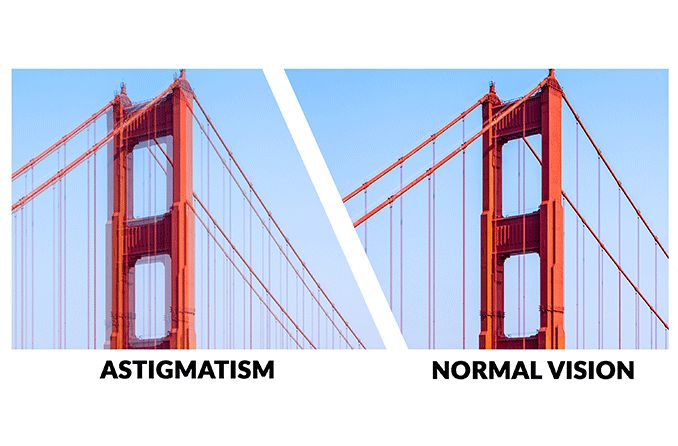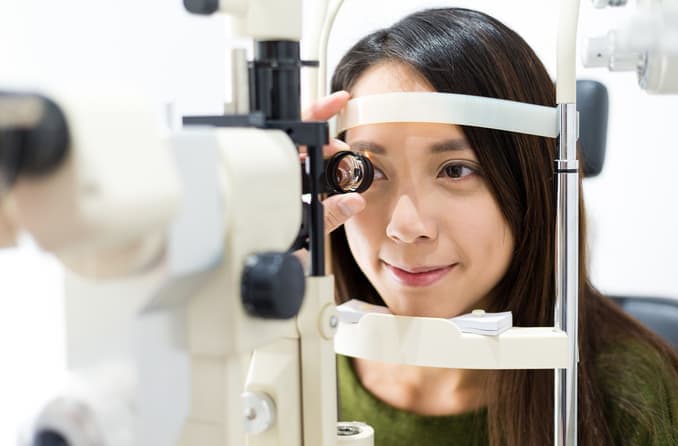What causes astigmatism?
Astigmatism is a condition caused by subtle flaws in the way your eye bends light (a process called refraction) that passes to the retina, the light-sensitive area at the back of the eyeball. The optic nerve transmits nerve impulses from the retina to the brain, which translates them into eyesight.
Astigmatism is not a disease; it is simply a type of refractive error that causes blurry, fuzzy or distorted vision.
Astigmatism is one of four common kinds of refractive error. You may have heard of the other three: myopia (nearsightedness), hyperopia (farsightedness) and presbyopia (age-related farsightedness).
If your vision works properly, your cornea and the lens behind it refract light into the retina. Alas, imperfections in the curvature of the cornea or the lens (or both) can prevent images from properly focusing on the retina. The brain perceives these ocular foul-ups as unclear or distorted images.
Your cornea is a transparent dome covering the front surface of the eye. It’s curved like the lens on a telescope or camera. A perfectly curved cornea and natural lens focus light signals on the retina to produce crisp, clear vision in the brain.
Unfortunately, corneas and lenses may have imperfect curves that interfere with refraction, generating the fuzzy or distorted vision that we call astigmatism. Defects in other structures within the eye may also contribute to astigmatism.
Symptoms of astigmatism
Common signs and symptoms of astigmatism include:
- Squinting
- Blurred or distorted vision at all distances
- Poor night vision
- Eyestrain
- Headaches
Diagnosis
During a comprehensive eye exam, your eye doctor can check your vision and measure the shape of your eye. They'll use one or more eye exam tests to help them diagnose astigmatism. The two common tests are:
- Refraction test – While seated, you look at rows of letters on an eye chart through a mask-like device called a phoropter. The eye doctor flips the lenses and asks you which lenses make the letters look clearer.
- Retinoscopy – The doctor shines a light in your eye while you look through different lenses. This continues until they find one that best clarifies your eyesight. A retinoscopy is usually only used for children and adults who can't have a refraction test.
Sections of the eye called meridians help your eye doctor identify high and low spots on the cornea that generate astigmatism. A measurement called a diopter estimates how much refraction happens in each meridian.
The meridians of the eye look like the face of a traditional clock. One main (principal) meridian, for example, is the line connecting the 6 (bottom) to the 12 (top). Another is the line from 9 (left) to 3 (right).
Eye doctors assess the differences between the meridians of the eye to determine the proper prescription to produce clear vision.
READ MORE: What to expect from your astigmatism test
Astigmatism in children
Many babies are born with astigmatism, though it often clears up within the first year. However, some children do not outgrow their astigmatism, and uncorrected astigmatism can negatively impact learning and development. It can also lead to other eye problems, like amblyopia (lazy eye).
Thus, it is important to schedule regular eye exams for children in order to detect astigmatism and/or other uncorrected refractive errors.
READ MORE: How astigmatism can affect babies and children
Types of astigmatism
Astigmatism is sorted into different types — each one looks at a different way the condition changes your eyes. This means that you'll have more than one type of astigmatism at the same time.
These types are based on:
The affected part of your eye
To start, there are two main astigmatism types based on which part of your eye is affected:
- Corneal – Your cornea has an irregular shape. This is most common.
- Lenticular – The lens inside your eye has an irregular shape. This can be related to cataracts, which also affect your lens.
It's possible to have both of these at the same time.
The shape and location of the curve
Then, there are types of astigmatism based on how your cornea or lens is curved. They are:
- Regular – The curve is abnormal, but the imperfection is spread out in a symmetrical way. This can usually be corrected with basic prescription glasses or contacts.
- Irregular – The curve is uneven and less predictable. This is less common and harder to treat.
There are four types of regular astigmatism called "subtypes:"
- With-the-rule – The vertical meridian (top to bottom) has a steeper curve than the horizontal one (side to side). This is the most common subtype.
- Against-the-rule – The horizontal meridian is steeper than the vertical one. This subtype is more common in people over 40.
- Oblique – The steepest part of the curve isn't aligned horizontally or vertically; it's somewhere in between.
- Bi-oblique – The two meridians aren't perpendicular to each other, meaning they aren't 90 degrees apart.
Where light focuses inside your eye
Eye doctors also use terms to categorize the way light hits your retina:
- Simple – One meridian does a good job of focusing light on the retina, but the other one doesn't. This is called simple myopic (nearsighted) if light focuses in front of the retina. It's simple hyperopic (farsighted) if light focuses past the retina.
- Compound – Both meridians focus light in the same incorrect way, either in front of or behind the retina.
- Mixed – One meridian focuses light in front of the retina, and the other one focuses it behind the retina.
Treatments for astigmatism
Eyeglasses, contact lenses and some eye surgeries like LASIK can correct most types of astigmatism.
Eyeglasses
Prescriptive lenses correct refractive errors in the cornea and lens of the eye. Regular astigmatism should be correctable to 20/20 vision, though astigmatism may be too severe to fully correct vision.
If you have irregular astigmatism, it can be hard to correct your vision with glasses alone. But specialized contacts could help you get to 20/20 vision.
Contact lenses
Many people choose to correct their astigmatism with one of two types of contact lenses:
- Toric soft lenses – These soft contacts can have different levels of refraction that align with individual meridians of the eye, enabling precise vision corrections. Because of their complex designs, toric contacts are often more expensive than soft contacts that don't correct astigmatism.
- Gas permeable lenses – Rigid gas permeable (RGP) lenses are firmer than their soft toric counterparts. They let more oxygen reach your cornea. RGP lenses may be less comfortable than soft lenses initially, but they can provide superb vision correction and comfort with time. RGP lenses can correct irregular astigmatism, unlike glasses and soft contacts.
Astigmatism surgery
Operations to reshape the cornea can correct astigmatism. For instance, LASIK surgery uses high-precision lasers to make the cornea more symmetrical and can be used to correct some people's astigmatism permanently.
If you have cataracts, an eye surgeon can place a toric intraocular lens (IOL) implant into your eye to correct astigmatism and remove the cataract at the same time. Note that a toric IOL is typically more expensive than a standard lens implant.
Talk to an eye doctor
Everybody’s vision is different, which means every form of astigmatism has a unique impact. This means you have to pay extra attention to the fit and function of your eyeglasses or contact lenses.
Schedule an eye exam so you can talk to an eye doctor about astigmatism. They will test your vision and, if you have astigmatism, help you decide whether glasses, contacts or surgery is a good option for you.
FAQs
Q: How does astigmatism affect night driving?
A: Night driving with uncorrected astigmatism can be a tricky task. This is because astigmatism makes light scatter inside the eye instead of focusing on a single point on the retina. People with astigmatism might see distracting glare or halos around street lights and traffic lights. This can have a negative effect on night driving.
Q: Can you get contact lenses for astigmatism?
A: Yes, you can get contact lenses for astigmatism. There are two main options: soft toric lenses and RGP lenses. Each lens offers different benefits, so it’s best to talk with your eye doctor to find out which astigmatism contact lenses are best for your situation.
Q: How are astigmatism glasses different from other glasses?
A: The lenses in astigmatism glasses have extra specifications for astigmatism. Cylinder (listed as CYL on a vision prescription) is the amount of astigmatism your lenses need to correct. Someone with astigmatism will also have an axis specification, which denotes the rotation of the astigmatism correction (in degrees). Someone without astigmatism will not have a CYL or axis specification.
Your doctor will review all available treatment options with the goal of developing clear, comfortable and efficient vision.






